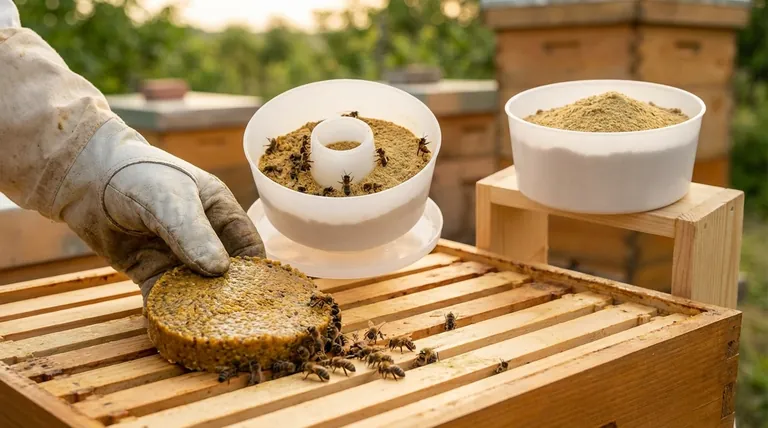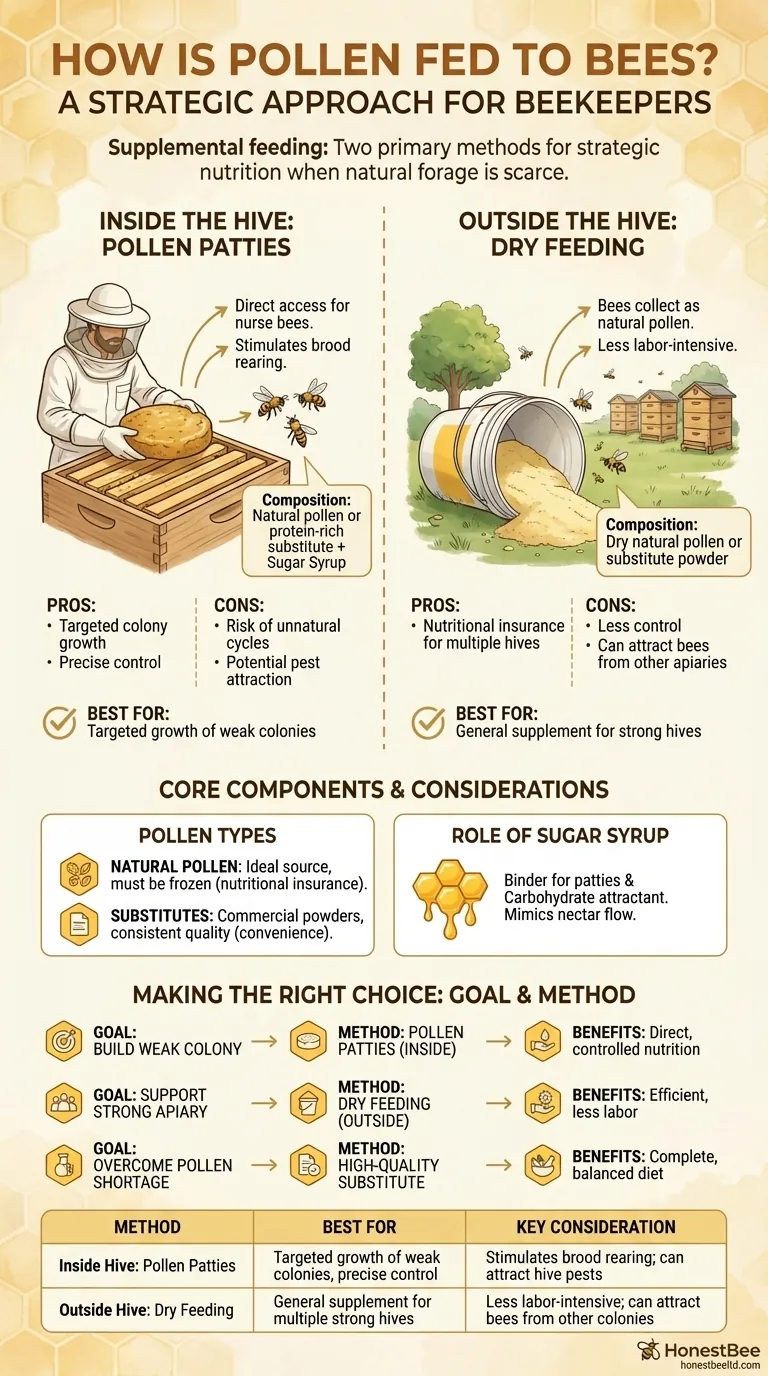Pollen is fed to bees using two primary methods: as a moist patty placed directly inside the hive, or as a dry powder in a feeder outside the hive. This supplemental feeding is a strategic tool used by beekeepers to provide nutrition when natural forage is scarce, typically at the very beginning of the brood-rearing season to stimulate colony growth.
The method of feeding pollen is straightforward, but the critical decision for a beekeeper is why and when to do it. While supplemental feeding can be a powerful tool to strengthen a colony, improper timing can disrupt the hive's natural cycle and create an imbalance of resources.

The Two Primary Feeding Methods
A beekeeper’s choice of feeding method depends on their specific goal, the number of hives, and the level of control they wish to exert over the colony's consumption.
Inside the Hive: Pollen Patties
Pollen patties are the most direct way to deliver protein to a colony. They consist of natural pollen or a protein-rich pollen substitute mixed with sugar syrup to form a moist, dough-like cake.
These patties are placed directly on top of the frames inside the hive. This placement makes the food immediately accessible to nurse bees, encouraging them to consume the protein and begin or expand brood rearing. This method provides a controlled, targeted nutritional boost.
Outside the Hive: Dry Feeding
The alternative is open or dry feeding. In this method, dry pollen or pollen substitute powder is placed in a large, noticeable container a short distance from the hives.
A five-gallon bucket on its side or a repurposed bird bath can serve as a feeder. Bees will find the powder, collect it as they would natural pollen, and carry it back to the hive. This method is less labor-intensive for the beekeeper but offers less control, as the food is available to any bees in the area.
Understanding the Core Components
The "pollen" being fed is not always what it seems. The mixture and its quality are just as important as the delivery method.
Natural Pollen vs. Pollen Substitutes
Natural bee pollen is the ideal source of protein. If you use it, it must be properly preserved—freezing is the preferred method to maintain its nutritional value indefinitely.
Pollen substitutes are commercially manufactured powders rich in protein and formulated to mimic the nutritional profile of real pollen. These are widely used in commercial operations and by hobbyists for their convenience and consistent quality.
The Role of Sugar Syrup
Sugar syrup is a critical ingredient in pollen patties. It serves two functions: it acts as a binder to create the doughy consistency, and it functions as a carbohydrate-rich attractant that encourages bees to consume the patty. Feeding sugar syrup can also mimic a natural nectar flow, further stimulating the queen to lay eggs.
Understanding the Trade-offs and Timing
Supplemental feeding is a deliberate intervention in the colony's life cycle. Understanding its purpose and risks is essential for success.
Pro: Targeted Colony Growth
The primary reason to feed pollen is to stimulate brood production in late winter or early spring. This ensures the colony's population peaks in time for the main nectar flow, maximizing honey production or preparing them for pollination contracts. It can also be used to help a weak colony catch up.
Pro: Nutritional Insurance
In areas with poor forage diversity (monocultures) or during a sudden pollen dearth, supplemental feeding ensures the colony receives the balanced diet it needs to thrive. A lack of diverse protein sources can weaken a hive's collective immune system.
Con: Risk of Unnatural Cycles
Timing is everything. Feeding pollen too early in the season can create a large population of nurse bees with no brood to tend to, straining the hive's winter stores. Feeding too late can be a waste of resources if the natural pollen flow has already begun.
Con: Potential Attraction for Pests
Pollen patties inside a hive can attract pests like Small Hive Beetles, which lay their eggs in the patty. Open feeders outside can attract bees from other apiaries, creating competition and potentially spreading diseases between colonies if not managed carefully.
Making the Right Choice for Your Colony
Your approach to feeding should be dictated by a clear goal for your hive's health and productivity.
- If your primary focus is rapidly building up a specific weak colony: Use pollen patties inside the hive for direct, controlled nutrition.
- If your primary focus is providing a general supplement to multiple strong hives: Open, dry feeding outside the hive can be an efficient method to support the apiary.
- If your primary focus is overcoming a known pollen shortage or lack of diversity: Providing a high-quality pollen substitute ensures your bees get a complete and balanced diet.
Ultimately, supplemental feeding is a strategic intervention, not a routine, and its success depends entirely on a clear understanding of your colony's specific needs and the natural environment.
Summary Table:
| Feeding Method | Best For | Key Consideration |
|---|---|---|
| Inside Hive: Pollen Patties | Targeted growth of weak colonies, precise control | Stimulates brood rearing; can attract hive pests |
| Outside Hive: Dry Feeding | General supplement for multiple strong hives | Less labor-intensive; can attract bees from other colonies |
Ready to strengthen your apiary? HONESTBEE supplies commercial apiaries and beekeeping equipment distributors with the high-quality pollen substitutes and feeding equipment needed for strategic colony nutrition. Our wholesale-focused operations ensure you get the reliable supplies to maximize your honey production and colony health. Contact our experts today to discuss your apiary's needs.
Visual Guide

Related Products
- Rapid Bee Feeder White Plastic 2L Round Top Feeder for 8 or 10-Frame Bee Hives
- Classic Boardman Entrance Bee Feeder Hive Front Feeding Solution
- HONESTBEE Entrance Bee Feeder Professional Hive Nutrition Solution for Beekeeping
- Professional Hive Top Bee Feeder for Beekeeping
- HONESTBEE Entrance Bee Feeder Efficient Hive Front Liquid Feeding Solution for Beekeeping
People Also Ask
- What is the capacity of the round hive top feeder for syrup and pollen? A Guide to Targeted Apiary Support
- What can the round hive top feeder be used for? A Guide to Efficient, Safe Bee Feeding
- How do you set up and use a top feeder for bees? A Step-by-Step Guide for Safe Feeding
- What is the advice regarding feeding bees to limit brood production based on? Managing Prolific Bee Strains
- How much honey does a strong hive need to survive winter? Ensure Your Colony's Survival (60-80 lbs)



















